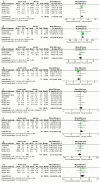Impacts of amino acid supplementation on renal function and nutritional parameters in patients with renal insufficiency: bibliometric analysis and meta-analysis
- PMID: 40584098
- PMCID: PMC12202395
- DOI: 10.3389/fnut.2025.1594507
Impacts of amino acid supplementation on renal function and nutritional parameters in patients with renal insufficiency: bibliometric analysis and meta-analysis
Abstract
Objective: The aim of this study was to summarize the effects of amino acids (AA) on renal function and nutritional indices in patients with renal insufficiency (RI) after treatment and to analyze the development trend in this field.
Methods: The bibliometric evaluation of scholarly contributions in this field was conducted using the Web of Science database, with data analyzed via Bibliometrix and VOSviewer software. The randomized controlled trials (RCTs) published before January 13, 2025, were systematically retrieved from Embase, PubMed, and the Cochrane Library and meta-analyses were performed using Review Manager 5.4 software.
Results: Key areas of focus included oxidative stress, chronic renal failure, hemodialysis, inflammation, chronic kidney disease, risk, plasma, progression, L-arginine, disease, and renal failure. Nine RCTs involving 407 participants were included, AA administration demonstrated significant effects compared to placebo: Increased blood urea nitrogen (MD: 4.21, 95% CI: 1.08 to 7.35, p = 0.008), elevated renal plasma flow (MD: 30.78, 95% CI: 15.36 to 46.21, p < 0.0001), and reduced uric acid levels (MD: -0.47, 95% CI: -0.89 to -0.06, p = 0.02).
Conclusion: These findings suggest that AA supplementation may partially improve renal function in RI patients. The progression and possible mechanisms of chronic kidney disease, as well as the search for new biomarkers, will be the trend of research and development in this field.
Keywords: amino acids; bibliometrics; meta-analysis; nutritional indicators; renal function; renal insufficiency.
Copyright © 2025 Liu, Li, Zhang, He, Tan, Chen and Li.
Conflict of interest statement
The authors declare that the research was conducted in the absence of any commercial or financial relationships that could be construed as a potential conflict of interest.
Figures





Similar articles
-
Higher versus lower amino acid intake in parenteral nutrition for newborn infants.Cochrane Database Syst Rev. 2018 Mar 5;3(3):CD005949. doi: 10.1002/14651858.CD005949.pub2. Cochrane Database Syst Rev. 2018. PMID: 29505664 Free PMC article.
-
Systemic pharmacological treatments for chronic plaque psoriasis: a network meta-analysis.Cochrane Database Syst Rev. 2021 Apr 19;4(4):CD011535. doi: 10.1002/14651858.CD011535.pub4. Cochrane Database Syst Rev. 2021. Update in: Cochrane Database Syst Rev. 2022 May 23;5:CD011535. doi: 10.1002/14651858.CD011535.pub5. PMID: 33871055 Free PMC article. Updated.
-
Nutritional interventions for survivors of childhood cancer.Cochrane Database Syst Rev. 2016 Aug 22;2016(8):CD009678. doi: 10.1002/14651858.CD009678.pub2. Cochrane Database Syst Rev. 2016. PMID: 27545902 Free PMC article.
-
Antioxidant vitamin and mineral supplements for slowing the progression of age-related macular degeneration.Cochrane Database Syst Rev. 2017 Jul 31;7(7):CD000254. doi: 10.1002/14651858.CD000254.pub4. Cochrane Database Syst Rev. 2017. Update in: Cochrane Database Syst Rev. 2023 Sep 13;9:CD000254. doi: 10.1002/14651858.CD000254.pub5. PMID: 28756618 Free PMC article. Updated.
-
Selective progesterone receptor modulators (SPRMs) for uterine fibroids.Cochrane Database Syst Rev. 2017 Apr 26;4(4):CD010770. doi: 10.1002/14651858.CD010770.pub2. Cochrane Database Syst Rev. 2017. PMID: 28444736 Free PMC article.
References
-
- Stein G. Infusionstherapie und parenterale Ernährung bei akutem Nierenversagen und chronischer Niereninsuffizienz [infusion therapy and parenteral nutrition in acute renal failure and chronic renal insufficiency]. Z Gesamte Inn Med. (1980) 35:758–62. - PubMed
Publication types
LinkOut - more resources
Full Text Sources

